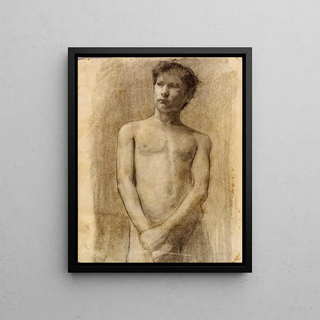Art print | Study of a young man - Henry Ossawa Tanner


View from behind

Frame (optional)
In the vibrant world of art, some works transcend their era to become timeless witnesses to the human condition. "Study of a Young Man - Henry Ossawa Tanner" fits into this tradition. This painting, which captures the very essence of youth and contemplation, invites us to delve into the inner universe of a young man whose gaze seems to carry the weight of dreams and aspirations. Tanner, an African-American artist of the early 20th century, manages to create a silent dialogue between the subject and the viewer, making this piece emotionally powerful and rare. The light, shadows, and expressions blend together to bring to life a scene that, although frozen, seems to vibrate with palpable energy.
Style and uniqueness of the work
The piece stands out for its subtle treatment of light and color, characteristic of Tanner's style. The artist uses soft lighting to highlight the features of the young man, thus emphasizing his introspection. The nuances of warm and cool colors harmonize beautifully, creating an atmosphere that is both soothing and tense. The choice of the subject's clothing, simple yet elegant, reflects a certain dignity, while the relaxed pose suggests psychological depth. Tanner does not merely depict a young man; he captures a moment of reflection, a pause amid life's tumult. This ability to infuse a narrative dimension into the painting makes "Study of a Young Man" a work that resonates with anyone who has ever experienced the uncertainty of adolescence.
The artist and his influence
Henry Ossawa Tanner, often regarded as a pioneer of African-American art, managed to establish himself in an artistic environment often dominated by exclusive standards. His career, marked by a quest for authenticity and recognition, was filled with success, especially in Europe, where he found an audience receptive to his innovative approach. Tanner was influenced by European masters, but he also drew from his cultural roots to develop a unique style. His commitment to universal themes, such as faith, struggle, and identity, paved the way

Matte finish

View from behind

Frame (optional)
In the vibrant world of art, some works transcend their era to become timeless witnesses to the human condition. "Study of a Young Man - Henry Ossawa Tanner" fits into this tradition. This painting, which captures the very essence of youth and contemplation, invites us to delve into the inner universe of a young man whose gaze seems to carry the weight of dreams and aspirations. Tanner, an African-American artist of the early 20th century, manages to create a silent dialogue between the subject and the viewer, making this piece emotionally powerful and rare. The light, shadows, and expressions blend together to bring to life a scene that, although frozen, seems to vibrate with palpable energy.
Style and uniqueness of the work
The piece stands out for its subtle treatment of light and color, characteristic of Tanner's style. The artist uses soft lighting to highlight the features of the young man, thus emphasizing his introspection. The nuances of warm and cool colors harmonize beautifully, creating an atmosphere that is both soothing and tense. The choice of the subject's clothing, simple yet elegant, reflects a certain dignity, while the relaxed pose suggests psychological depth. Tanner does not merely depict a young man; he captures a moment of reflection, a pause amid life's tumult. This ability to infuse a narrative dimension into the painting makes "Study of a Young Man" a work that resonates with anyone who has ever experienced the uncertainty of adolescence.
The artist and his influence
Henry Ossawa Tanner, often regarded as a pioneer of African-American art, managed to establish himself in an artistic environment often dominated by exclusive standards. His career, marked by a quest for authenticity and recognition, was filled with success, especially in Europe, where he found an audience receptive to his innovative approach. Tanner was influenced by European masters, but he also drew from his cultural roots to develop a unique style. His commitment to universal themes, such as faith, struggle, and identity, paved the way






